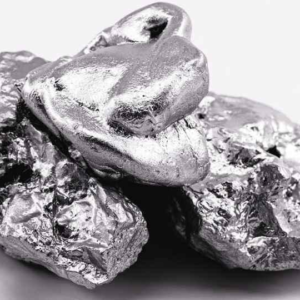の理解 錫の融点 重要です. 通常, 錫は231.9℃で溶けます (449.4°F). 錫の融点が低いことが、はんだ付けの鍵となります. 合金の作成にも役立ちます. 錫の融点は工業プロセスに影響を与える. デザインメーカーは精度のために錫に依存しています, エレクトロニクスにおける材料の最適化に役立つため. 融点も熱安定性に影響します. 調べてみましょう 錫の融点詳細.
錫はどのくらいの温度で溶けますか?
生の状態の錫
錫が溶けるのは、 231.9℃ (449.4°F), 金属の中でも比較的低温. 錫は融点が低いため、電子機器のはんだ付けに最適です。. 加えて, 温度に敏感なプロセスの精度を保証します.
錫の融解温度を他の金属の融点と比較する
錫の融点と他の一般的な金属の比較は次のとおりです。:
| 金属 | 融点 (℃) | 融点 (°F) |
| 錫 | 231.9 | 449.4 |
| 鉛 | 327.5 | 621.5 |
| アルミニウム | 660.3 | 1220.5 |
| 銅 | 1084.62 | 1984.3 |
| 銀 | 961.8 | 1763.2 |
| 金 | 1064 | 1947 |
| 鉄 | 1538 | 2800 |
| 白金 | 1770 | 3218 |
上の表は、錫と他の金属の融点の大きな違いを比較しています。.
錫の融点と沸点の比較
錫の融点は231.9℃です (449.4°F). この温度では, 錫は固体から液体に変化します. 一方で, 錫の沸点は2270℃です (4118°F). 沸点は、錫が液体から気体に変化する典型的な温度です。.
この 2 つの点は、さまざまな産業プロセスにとって重要です。, 合金の作成や熱管理など. 融点と沸点の差が大きいため、錫は室温および高温で多くの用途で安定しています。.
錫の融点が異なる理由?
錫には沸点が固定されています, 密度, と融点温度. しかし, これらの要因は、特定の範囲の条件で変化する傾向があります. 純錫の通常の融点は約. 231.9℃ (449.4 °F). 錫の融点が変化する主な理由は次のとおりです。:
1. 錫の純度
純錫の融点は231.9℃です。. しかし, 不純物が存在する場合, 融点は変わります. 欠陥は原子の配置を変化させ、錫の溶けやすさや溶けにくさを変化させます。. 例えば, 少量の銅または鉛は融点を下げる可能性があります, 一方、ヒ素などの他の金属はそれを増加させる可能性があります.
2. 合金組成
合金は多くの場合、ベースメタルよりも融点が低くなります。. これははんだ付けに役立ちます. 例えば, 鉛錫はんだは、純粋な錫よりもはるかに低い融点を持っています。. 合金の溶解温度は、使用される金属の種類と濃度によって異なります。.
3. 圧力条件
圧力は錫の融点を変化させる際に重要な役割を果たします. 錫には、通常の大気圧下で溶ける標準温度があります。. それにもかかわらず, このような材料を使用すると、融点が上昇する可能性がある条件があります。. たとえば、高度に特殊な産業用途において. 一方で, 圧力が低い場合、融点は予想よりわずかに低くなる可能性があります.
4. 加熱速度
錫の加熱速度は溶解プロセスに影響を与える可能性があります. 温度をより細かく制御できるため、固体と液体の相の急速な変化を回避できます。. これらの変化は亀裂を引き起こす可能性があります.
それにもかかわらず、, 加熱速度が高いと、材料内に温度勾配が生じ、その結果、不均一な溶融が生じることが知られています。. 高度に制御されたプロセスで, 加熱速度を適切に制御する必要がある.
5. 酸化物または汚染物質の存在
酸化や表面汚染物質は、錫の融点に影響を与えることがよくあります。. 酸素と接触すると, 錫は不動態酸化膜を形成し、溶解を妨げる可能性があります. 加えて, 正確な溶解が必要なプロセスでは、錫の表面を酸化から守ることが依然として重要です.
錫の低融点の限界
錫は融点が比較的低い, その過程でデメリットが生じる. 錫を産業および工学の観点から見るときは常に、このような制限をすべて考慮する必要があります。.
1. 高温での用途はほとんどない
錫は溶けたり劣化しやすい. それは通常起こります, それ以上の熱にさらされると 232 C. これにより、航空宇宙や重工業などの用途での使用が制限されます。. なぜなら, 温度安定性の向上が関係する場合.
2. 高温での応力耐力の低下
錫は溶融温度付近では機械的特性が劣ります. これにより、高温ストレス条件などのストレス条件への耐性が低下します。. その結果, 高い使用温度での熱膨張や機械的負荷の影響を受けやすい用途では、錫の使用を避けることが望ましい場合があります。.
3. 腐食しやすさ
錫は耐食性に優れた素材ですが、, しかし, 熱にさらされると, 酸化が早くなります. 用途によっては酸化して機能を低下させる層を形成する可能性があります, 触媒の中など.
4. 高性能合金との相性が悪い
それにもかかわらず、, 融点の高い合金は錫と組み合わせると良好な結果が得られない可能性があります. このため、金属に高い強度と安定性を持たせる必要がある分野での高性能合金の開発での使用が制限されます。.
5. 精密はんだ付けの難しさ
錫は、ほとんどのはんだ付け用途に使用されることが多い. 融解温度が低いため、その用途には問題が生じる場合があります。. 特定の条件下では, はんだ付けボンドの制御が難しくなる可能性がある. 特に, 関節を許容することができます, はんだ付け時に熱が加わると変形しやすくなったり、デリケートな部分を傷つけたりすることがあります。.
融点が低い錫の用途
錫は、熱制御が重要なプロセスでの使用に適した特性を備えています。. 以下に錫の主な用途をいくつか示します。:
1. エレクトロニクスにおけるはんだ付け
錫リード線のはんだ付け
錫ベースのはんだは電子部品の接合に使用されます. 融点が低いため、変形を引き起こすことなく正確で安定した接触が可能, アセンブリの望ましくない接触.
2. 合金の製造
錫は錫と鉛の合金や錫青銅に使用されます。. したがって, それは作る 合金 さまざまな用途に比較的低温で溶ける.
3. コーティングとメッキ
錫は腐食から保護するために金属のメッキに使用されます. 融点が低いため、さまざまな用途に使用できます。 鋼鉄, 銅, および均一な厚さのその他の材料.
4. 低温ヒューズの製造
錫は電気回路の低温ヒューズに最適です. 融解温度が低いため、, 簡単に溶けて回路の過熱を防ぐことができます。.
5. 食品包装
食品缶のメッキには錫が使用されており、腐食から保護されています。. 保護層として, 融点が低いため簡単に塗布できます.
まとめ
錫の融点が低いため、さまざまな業界にさまざまなメリットがもたらされます。, エレクトロニクスから食品包装まで. 比較的低温で溶融および凝固する能力があるため、はんだ付けなどの精密な用途に最適です。, 合金の生産, およびコーティング. 融点が低いため、高温環境ではいくつかの制限が生じる可能性があります, 溶けやすさが求められる産業にとって、依然として重要な材料です。, 耐久性, そして安全性.
錫の融点に関するよくある質問
Q1. 錫の融点は他の一般的な金属とどう違うのか?
錫は231.9℃という比較的低い温度で溶けます。, これは鉄などの金属よりも大幅に低い (1538℃) と銅 (1084℃), 容易な溶解が必要な用途に最適です.
第2四半期. 錫の低融点はエレクトロニクス産業にどのような影響を及ぼしますか?
エレクトロニクス分野, 錫は融点が低いため、繊細な部品のはんだ付けに最適です. さらに, 組み立て中の熱損傷を防ぎ、回路基板での効率的な接続を可能にします。.
Q3. 錫の融点は錫メッキ製品の耐久性にどのような影響を与えるのか?
錫は融点が低いため、高温になると摩耗しやすくなります。, 極端な高温条件下では、食品缶や電気部品などの錫メッキ製品の耐久性に影響を与える可能性があります。.
Q4. 他の金属と合金化すると錫の融点は変化しますか?
はい, 錫が鉛や銀などの他の金属と合金化される場合, 融点は上昇または低下する可能性があります, 合金の組成に応じて, 特定の産業用途により適したものにする.
Q5. 低温ヒューズに錫が好まれる理由?
錫は融点が低いため、過剰な電流が流れたときにすぐに溶けて回路を安全に遮断できるため、低温ヒューズに最適です。, 繊細な電子機器を保護する.






1 「」について考えました錫の融点についてのすべてはここにあります”